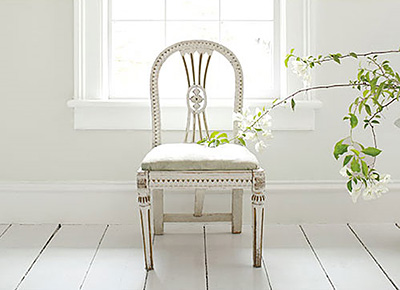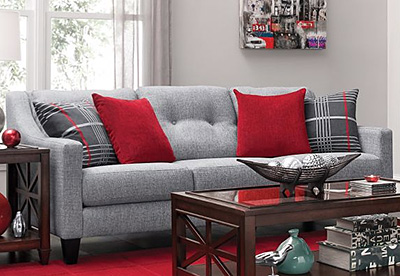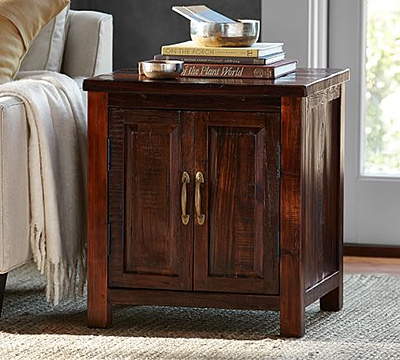Choosing Products to Complete Your Green Home
by Rachel Lyon, Editorial Director for Direct from the Designers™
Maybe the home you build will be ENERGY STAR® approved, or maybe you’ve looked for efficient appliances that will cut your consumption and your bills to help preserve our environment. Designing a green home is a serious undertaking in today’s world. It seems like there’s a more eco-friendly alternative for every home building decision out there, and it can be overwhelming for the average consumer to take it all in. But it’s true—there are many facets to green construction and design, and you might not be aware of them all. As you try to make responsible choices, here are some of the areas you could still be missing and information to help you understand them.
Eco-Friendly Paint
Going to paint something? First take a look at exactly what you’re buying. Throughout most of its history, paint has contained harmful chemicals to make it easier to use and more long-lasting, but the growing market for green products has expanded the choices available and now you can make a healthier purchase for your home.
Paint consists of pigments and a base of binders and solvents. Pigments provide color and binders are the solids that help the pigments stick to a surface. Solvents are what keep the paint liquid until applied, and they evaporate to leave the solid colored layer you want. These solvents are volatile organic compounds (VOCs) and can include formaldehyde, toluene, benzene, and numerous other chemicals that are responsible for causing headaches and dizziness, and they are the reason you should always paint in a ventilated space. VOC emissions are highest as paint dries, but they actually continue for years, and they still affect human health. They can be carcinogenic and toxic, causing damage to the liver and kidneys, and for particularly sensitive individuals, VOCs in a room that doesn’t even smell like fresh paint anymore can cause respiratory symptoms.
So, it’s clearly better for us to choose low- and no-VOC paints. But it is also incredibly important for the Earth, because the unstable nature of VOCs that causes them to evaporate so quickly also makes them reactive with nitrogen oxides in the air. These reactions produce ozone, which is great in the upper atmosphere but a harmful pollutant at ground level and a major component of smog. Ground-level ozone negatively affects plants by reducing their ability to perform photosynthesis, thereby slowing their growth and weakening their defenses against other chemicals, insects, and disease. Entire ecosystems feel the impact, because as plants die, insects and animals lose food and habitat sources. Along with this loss of diversity, water and other nutrient cycles get skewed, and balance is lost.
Paint is second only to cars for VOC emissions, and you can see just how much we could reduce pollution if everybody chose an eco-friendly paint. These water-based formulations have improved over the years, so they are easier to mix and don’t chip as easily as they used to. They might take longer to dry, but when you consider that they aren’t releasing such harmful chemicals into the air as they do, you won’t mind the extra time between coats!
Toxin-Free Furniture
Chances are you’ll sit on any new couch without a second thought, but maybe you should pause to consider what you’re introducing to your home when you go furniture shopping. Chairs and couches might include unadvertised chemicals that give them qualities that seem attractive, but that can have a negative impact on your health.
In 1975, manufacturers started to incorporate flame retardant chemicals in their products in response to Technical Bulletin 117, a standard introduced in California that had nationwide reach. This law required that all upholstered furniture and baby gear including polyurethane foam be loaded with chemicals like pentabrominated diphenyl ether—which is now banned around the world—and chlorinated tris—which is still in use despite being linked to cancer and neurological deficits—but now we know that things treated with these compounds are more dangerous in fires than untreated materials because they produce toxic gases when burned, and they don’t prevent the surface fabric from catching fire, anyway. Even in normal circumstances, these flame retardants emit gases and leave a chemical film of carcinogens and endocrine disruptors around the house. An updated law that set a new flammability test standard only went into effect in 2014, and while it can be passed without the use of such dangerous chemicals, it does not ban their use. Manufacturers are not required to label products that contain them, so you must inquire yourself to find products you will feel comfortable using.
Furniture surfaces have also been subject to chemical treatments that pose a risk to your health. Coatings of perfluorinated compounds (PFCs) have been added to fabrics in an effort to make them stain-resistant, because they have the ability to repel both oil and water. The problem is that they induce tumors, are toxic to the liver, damage the immune system, and can even cause low birth weight for babies born to mothers with high exposure. Unfortunately, PFCs can be found everywhere, including food packaging, non-stick cookware, and cleaning products, but removing sources of exposure is becoming easier as more companies find alternatives to serve the growing demand. Now, fabrics that inherently repel stains are available and are finding use in furniture.
Most of these chemicals can be found in human tissues and in wildlife. They do not break down in the environment and bioaccumulate in offspring and up the food chain—meaning their concentrations and effects get worse with time. By making informed buying decisions, we can stop introducing toxic chemicals into our homes and improve our own health and that of surrounding ecosystems.
Green Furnishings
Now that we’ve covered the major sources of indoor pollution that you can avoid, it’s time to think about outfitting your home with products that carry your commitment to the environment throughout your design. Just because you insist on eco-friendly living doesn’t mean you can’t enjoy a well-furnished interior with beautiful pieces made of natural materials!
Luckily, retailers are responding to the demand for more responsible use of our resources. Not only can you find attractive wooden furniture made using fast-growing, renewable species, but there is also a growing market for reclaimed wood. It can be found anywhere—collected from dilapidated old barns, recycled from antique hutches and tables that have seen better days, or taken from storage yards after never being bought for its intended use—and so it comes in any style you could want. Depending on the restoration done to the wood, you can get something that looks brand new or worn and rustic. You can even buy pieces that you might not be able to get otherwise due to restrictions on harvesting endangered trees. The possibilities are endless, and you can find reclaimed tables, chairs, desks, etc., so you can create an entirely reclaimed, unique set if you want!
You can also purchase organic textiles for your home, including curtains and area rugs. Woven using organically grown cotton, sisal, hemp, jute, or other natural fibers and colored with gentle vegetable dyes, these products are a sound eco-friendly decision. Many consumers choose them because they’re more allergy- and asthma-friendly, having been processed without harsh chemicals. Organic textiles also help to reduce pollution caused by conventional farming practices and support sustainable agriculture.
There are so many ways to be green and incorporate eco-friendliness into your home. Take the time to research all the options out there and decide which ones to invest in—your investment will positively affect not only you and your family, but all of us!
BROWSE HOME PRODUCT ARTICLES
- Creating a Spa-Like Master Bathroom »
- Designing a Water-Efficient Bathroom »
- Design a Modern Bathroom »
- View All Bathroom Articles »
- Building a New Home »
- Building a Duplex »
- Finding the Right Home Builder »
- View All Building Tips Articles »
- Adding the Right Columns»
- Decorative Touches for Your Interior»
- Shutters for Every Architectural Style »
- View All Columns & Millwork Articles »
- How to Use Specialty Laminates »
- Decorative Touches for Your Home's Interior
- View All Countertops and Surfaces Articles »
- What Goes Into a Great Deck? »
- Decorative Touches for Your Home's Interior »
- View All Decking Articles »
- Choosing Glass for Your Entry »
- Stylish Personas for Your Front Door »
- Using Sidelites and Transoms »
- View All Door Articles »
- Choose Siding for Your Region »
- Get the Most Out of Exterior Paint »
- Mixing Siding to Define Your Exterior »
- View All Exterior Articles »
- Finding the Right Home Builder »
- The Appeal of Small House Plans »
- Choosing the Perfect Floor Plan »
- View All Finding a Home Plan Articles »
- Colorful Flooring for Your Home »
- Designing With Different Widths»
- Chic, Neutral, Gray Flooring »
- View All Flooring Articles »
- Garage Doors That Add Curb Appeal »
- Caring for Your Garage Doors »
- Benefits of Insulated Garage Doors »
- View All Garage Door Articles »
- Reclaimed Products for Your Home »
- Building a Green and Stylish Home »
- Benefits of Building with SIPS »
- View All Green Building Articles »
- Cool Gadgets for Your New Home »
- Creating a Hi-Tech Home »
- Efficient Gifts for New Homeowners »
- View All Home Electronics Articles »
- Improve Your Home's Air Circulation »
- How to Improve the Air Circulation in Your Home »
- View All HVAC Articles »
- Bedrooms Designed for Sleep »
- Selecting a Fireplace for Your Home »
- Crafting a Luxurious Master Suite »
- View All Interior Design Articles »
- Design the Perfect Outdoor Space »
- Dive into a Beautiful Pool »
- Design a Sizzling Outdoor Kitchen »
- View All Outdoor Living Articles »
- Apps to Help You Pick Paint Colors »
- Create the Perfect Mood with Paint »
- How to Read the Color Wheel »
- View All Painting & Decorating Articles»
- Creating a Spa-Like Master Bathroom »
- High-Impact Kitchen Upgrades »
- Creating a Water Efficient Bathroom »
- View All Plumbing Fixtures Articles»
- Cladding That Complements Your Exterior »
- Reasons to Consider Prefinished Siding »
- View All Siding & Cladding Articles»
- All About Solar Powered Skylights »
- Natural Lighting for the Dark Corners of Your Home »
- Design a Better Bedroom with Skylights »
- View All Skylight Articles»
.png)
.png)



